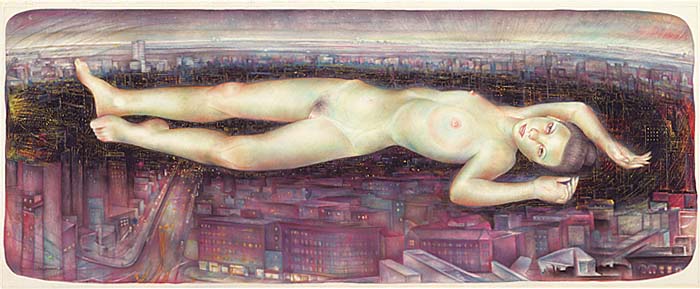
Purple Haze
Purple Haze is the last in a three picture series. These drawings (Dream Palace, Wildflowers, and Purple Haze) explore the different psychological states that can be generated by changes in the ambience surrounding a figure. Each of the three drawings depicts one particular nude in the same pose. While the subject and the position remains the same, the world around the subject changes. How then does the context influence our sympathies and relationships towards the subject?
When I began the last in this series, I envisioned an image of a woman, floating over the city. The vista comes from a friend’s apartment on the 19th floor of a building at 14th Street and 7th Avenue. I loved the view, which faced New Jersey and the World Trade Center. I asked a photographer friend of mine to accompany me to the apartment and he recorded the images. The picture is thus a kind of collage, a juxtaposition of the woman and the city.
Many interpretations have been expressed about this work. One can’t help wondering about the art historical conceit of wrapping the artist’s intentions up into one nice, neat package. Many times, the artist learns about the meaning of his work of art after it is completed. Perhaps there are secrets, hidden threads, which over time work their way into subconscious patterns.
In this very way, my perception of the piece ---dreamily standing by a window in twilight and observing a young former lover flying across the sky---is markedly different from my wife’s, for whom this picture conveys some highly sexual experience. Literally, for her, in this intense scene, the woman is floating up and out of the window into a panoramic view of the city. What she sees is some intense sexual state followed by a kind of ‘out of body’ encounter. (It is interesting to compare the male response which is ‘outer’ and the female which is ‘inner’.) Thus, this mystical scene of a woman floating into a panoramic view of the city opens doors to our own very personal thoughts and interpretations. A very sensitive student of mine riffed on this picture, mentioning that she didn’t see the nude at all, but that, for her, the picture is about the spirit and vulnerability of life in the city. Her spirited son described his interpretation of “‘multiple orgasms” spread out over an urban setting. So…who is right and, within reason and with humor, how much really does the artist know?
Shortly after I completed Purple Haze, three dear friends visited my studio. One of the visitors asked if I had ever read The Master and Margarita by Mikhail Bulgakhov. Not only had I not read the book but, at the time, I had not even heard of the writer. The very next day, my beautiful and thoughtful wife presented me with the gift of this book. When I began reading this stunning and magical novel I wondered about the reason for the recommendation. Then, about a third of the way through, I read a section that made the hair on my neck stand on end. My drawing could literally have been a visual interpretation of a key scene described in Bulgakhov’s book. I can only consider the connection between such a major work of literature and my picture as a great compliment. It speaks, also, to the mysteries of art.